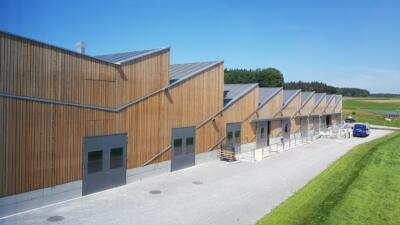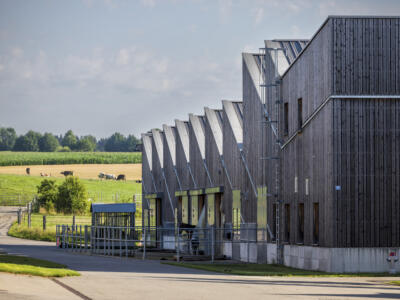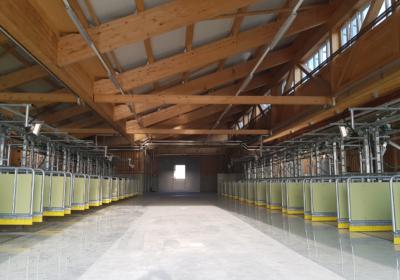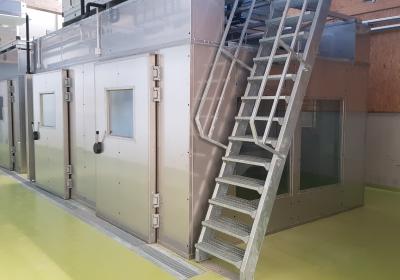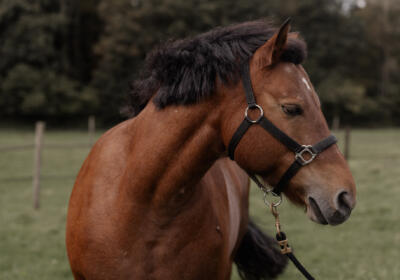The Metabolic Centre comprises the following four research units:
- Metabolism house with 24 spaces for tethered cattle, with one half of the barn which can be used either as a freestall barn or a deep litter barn:
- Measurement of milk performance
- Collection of faeces and urine from individual animals
- Individually prepared feed with weighing plate
- Respiration Chambers
- 4 chambers for cattle
- 4 chambers for pigs, goats, sheep and young cattle
- 4 chambers for poultry, rabbits, cats
- Further animal spaces
- 2 barns for large animals, not air-conditioned
- 1 sheep barn with 8 bays, not air-conditioned
- 1 goat and pig barn with 8 bays, air-conditioned
- 1 pig unit (air-conditioned with 8 bays)
- Poultry houses, air-conditioned with light control
- Rabbit pen
- 2 cat rooms
- Various feed and sample preparation rooms
Metabolism house
The metabolism house offers space for 24 cattle tethered in two rows, and one side can be used as a freestall barn with a deep litter area for smaller ruminant animals or for suckler cows with their calves when being used for experiments. The facilities allow individual measurements of feed intake by balances by METTLER TOLEDO and individual and quantative collection of faeces and urine when tethered. The metabolism house can also be adapted to tether beef cattle whose gas exchange will then be measured in the respiration chambers.
Respiration facility
The 12 respiration chambers are located in 3 rooms (4 in each room). There are 3 different sizes of respiration chambers for measurements of big animals (e.g. dairy cows and stock cattle), medium sized animals (e.g. goats, sheep, pigs, young cattle) or small animals (e.g. poultry, rabbits, cats). In the respiration chambers the gas exchange of the animals is measured i.e. oxygen use and carbon dioxide and methane emission. This allows energy balances to be created and methane emissions to be quantified.
Various barns for experiments
For research and education purposes various barns are available for horses, cattle, sheep, goats, pigs, camelids, selected zoo animals, poultry and cats.
Horses / Cattle
The two barns for large animals both have a big group box for 4 horses with a yard, as well as 3 individual boxes for experiments on horses or cattle.
Livestock barns
There are three barns for small livestock. One is for sheep and contains 8 bays (non air-conditioned). The other two each have 8 bays for either goats, sheep or pigs. One barn with 8 bays is specifically for pigs. These two barns are for special experiments and are therefore air-conditioned.
Poultry houses
On the upper floor there are three houses for poultry. One house is for breeding, another for broilers and the third for laying hens. These rooms are air-conditioned with light control and allow for data to be collected on feed consumption, performance and quality of eggs, carcasses and meat of individual animals.
Poultry houses
On the upper floor there are three houses for poultry. One house is for breeding, another for broilers and the third for laying hens. These rooms are air-conditioned with light control and allow for data to be collected on feed consumption, performance and quality of eggs, carcasses and meat of individual animals.
Poultry houses
On the upper floor there are three houses for poultry. One house is for breeding, another for broilers and the third for laying hens. These rooms are air-conditioned with light control and allow for data to be collected on feed consumption, performance and quality of eggs, carcasses and meat of individual animals.
Cat rooms
On the upper floor are two rooms for cats or similar small animals. The cats are kept for experiments on feed and faeces consistency as well as for metabolic experiments. The animals are kept either in individual boxes or in groups. One of the two rooms is used for the free movement of animals being kept in individual boxes.
Rabbit pen
On the upper floor is a pen for rabbits. They are kept for the production of antibodies for laboratory analysis. Experiments with individual animals are also possible. Rabbit breeding and fattening is also possible - the pens can hold both young and adult animals of various breeds.





